Polar Opposites: Ker & Downey's Guide to The Arctic and Antarctica
As Seen in Quest Magazine
On the surface, traveling to the polar regions might seem one in the same. They both contain vast icy expanses, suffer from the midnight sun of summer and the complete darkness of winter, and host certain wildlife that have the incredible ability to exist within extremes.
However, Antarctica and the Arctic have several key differences. The word "Antarctic," in fact, comes from the Greek word antarktikos, which translates as "opposite to the north."
Differences
Before planning your next Polar adventure, consider these important distinctions between our planet's furthest reaches.
Continent vs. Ocean
First, Antarctica is a continent—the southernmost continent on Earth. Surrounded by the Southern Ocean, the "Seventh Continent" contains about 70% of the world's freshwater, stored in the form of ice. It is indeed a single landmass covered by a year-round sheet of ice and has an overall higher elevation than the Arctic.
Meanwhile, the Arctic is an ocean surrounded by several continents and countries in North America, Europe, and Asia. The smallest and shallowest of the world's oceans, it encompasses the northernmost reaches of Alaska, Canada, Greenland, Iceland, Scandinavia, and Russia—otherwise known as the Arctic Circle. Rather than a single landmass, the Arctic Ocean has floating sea ice, which varies in its extent based on seasons and climate changes.
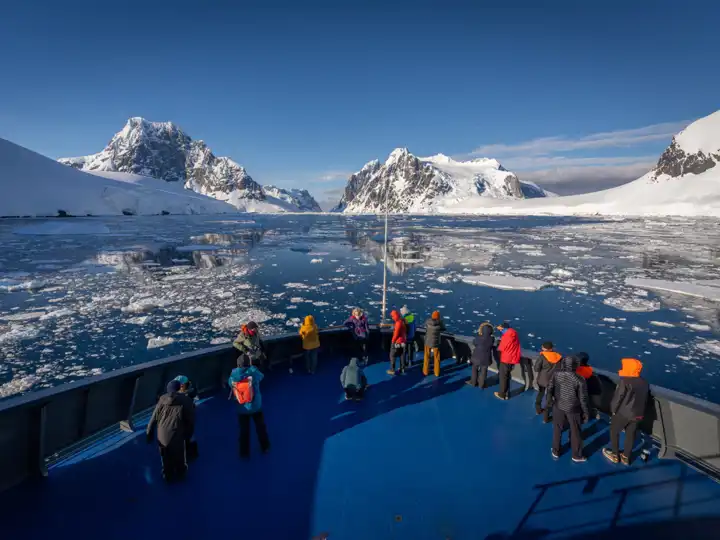
Winter vs. Summer
Their locations on the opposite sides of the planet result in the Arctic and Antarctic having opposite seasons.
Given the extreme weather conditions found in both, their cruising travel seasons are often relegated to their respective summer months when temperatures are milder and sea ice levels are lower, allowing for easier navigation. The Antarctica expedition season runs between November and March, while the Arctic expedition season typically runs between May and September.
However, concessions can be made for land-based explorations in the Arctic. For instance, the winter months in Lapland allow intrepid travelers to stay in exclusive snow and ice hotels, chase the Northern Lights, go dog sledding in remote regions, and, of course, visit Santa's Village.
Penguins vs. Polar Bears
Penguins can only be found in Antarctica, not the Arctic. These flightless birds have specifically adapted to life in the Southern Hemisphere and, therefore, mainly inhabit sub-Antarctic islands, the Antarctic continent, and the surrounding southern oceans. (You can find them as far north as Chiloé and the Galapagos Islands).
They cannot navigate the sea ice that comprises the Arctic the way seals and polar bears do. Plus, the Antarctic has no land predators, making it easier for penguins to thrive. A few key penguin species in Antarctica include the Adélie penguin, Emperor penguin, Chinstrap penguin, and Gentoo penguin.
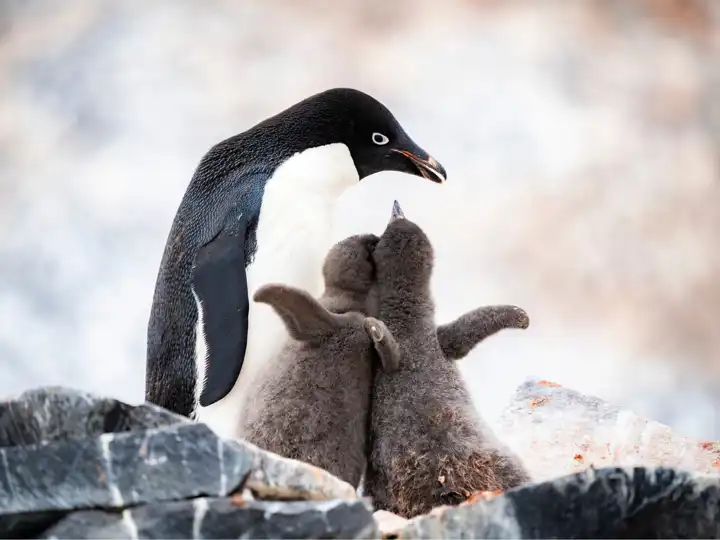
"I love watching the antics of penguins! Whether it's watching a penguin stealing rocks from a neighbor's nest, or watching them waddle to the sea. Sitting amongst hundreds of penguins in the remote landing site on the Antarctic peninsula is a wildlife lover's dream." -Trista Gage, Travel Designer
Meanwhile, polar bears can only be found in the Arctic, as they have evolved to thrive in the harsh sea ice environment of the Arctic Ocean. They stalk the northern reaches of Canada and Spitsbergen, hunting seals and belugas and utilizing the ice floes for survival. The polar bear would never thrive in Antarctica since the Southern Hemisphere does not have its preferred sea ice habitat.
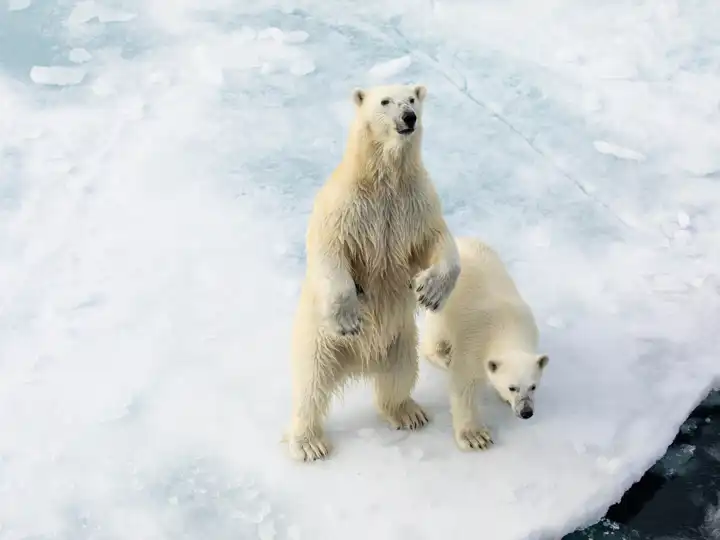
“I've been on countless safaris, but seeing the polar bears was truly a majestic wildlife experience. While they can only be safely viewed from quite a distance, watching them roaming the edge of the ice in the hunt for food really embodied both the power and fragility of this frozen part of the world.” -Tiffany Dunn, General Manager
Underwater vs. On Land
Besides penguins and polar bears, the Arctic and Antarctica have vastly different types of wildlife in their waters and on land.
Antarctica's wildlife will mostly be found underwater or in the air. Below water, there are several regional seals that do not exist beyond the continent, including the leopard seal, the Weddell seal, the crabeater seal, and the elephant seal. Then, of course, there are the whales. Several whale species such as minkes, orcas, humpbacks, and blues spend half the year here, and are especially active in March as they migrate up north.
Looking to the skies, Antarctica also boasts a plethora of seabirds, such as the southern fulmar, Antarctic petrel, snow petrel, and south polar skua.
The Arctic, meanwhile, has more land animals than Antarctica. Adorable mammals like Arctic fox, reindeer, Arctic hare, and wolf can be spotted in several key destinations such as Spitsbergen, Northern Lapland, and the Canadian Arctic. Puffins, too, are a highlight here.
And while a few key whale species—humpbacks, minkes, and fins, for instance—migrate to the Arctic waters in the spring months, only three types of whales call the Arctic home year-round: belugas, narwhals, and bowhead whales.
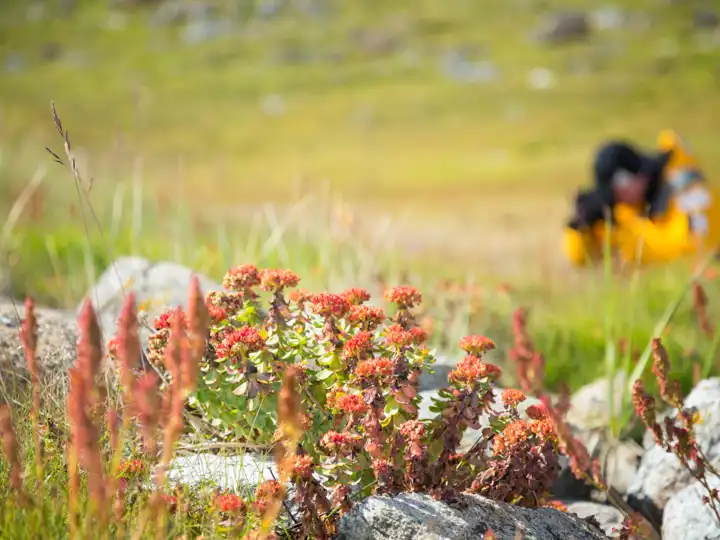
No Vegetation vs. Plenty of Vegetation
Antarctica has very little vegetation. What flora it does have is relegated to lichens, mosses, and algae, all of which have evolved to survive the extremely frigid, dry, and simple ecosystem. The only exception is the Antarctic hairgrass, the only native grass species that can survive on the cold continent.
The Arctic, however, has more diversity in its flora than the Antarctic. Featuring around 900 flowering plants, species such as Arctic poppies, Arctic willows, saxifrages, and other perennials have adapted to thrive amidst the cold temperatures and short growing seasons. These varietals flower quickly, and their seeds can withstand the harsh winters.
Uninhabited vs. Habited
Antarctica does not have an Indigenous population like the Arctic does. Outside of the research stations that attract seasonal workers, Antarctica remains entirely uninhabited. Instead, it is governed by the Antarctic Treaty System, an international agreement that designates Antarctica as a scientific preserve dedicated to research and peace.
More than 40 different Indigenous populations live in the Arctic, though, and interactions with these key groups remain a highlight on expeditions north. This includes the Inuit in Alaska, northern Canada, and Greenland, the Saami in Finland, Norway, Sweden, and northwestern Russia, and the Chuckchi in Siberia and eastern Russia.
Very Cold vs. Cold
Perhaps the least known fact about the polar regions is that Antarctica is generally much colder than the Arctic, on average. The main reason for this is that Antarctica is a high continent covered by a very thick layer of ice, whereas the Arctic experiences temperature fluctuations from ocean currents and seasons.

“I loved visiting the small communities in South Greenland, which were so welcoming. We sat and had fish stew and coffee at the community center with the locals, listened to the hunting stories of an elder, and sang with the village band.” -Catherine Brown, Travel Designer
Similarities
Now that you know their key differences, here is what the Earth's polar regions have in common.
Geological Diversity
Antarctica may be just a single landmass, but it is marked by its many mountain ranges, valleys, and the East Antarctic Plateau, home of the continent's highest peak: Dome Argus. Glaciers and ice shelves are overabundant.
The Arctic, too, boasts an incredible amount of geological diversity, which shouldn't be a surprise given its expansive reach across several continents. The landscape here, though, features more tundras, forests, and Arctic deserts.
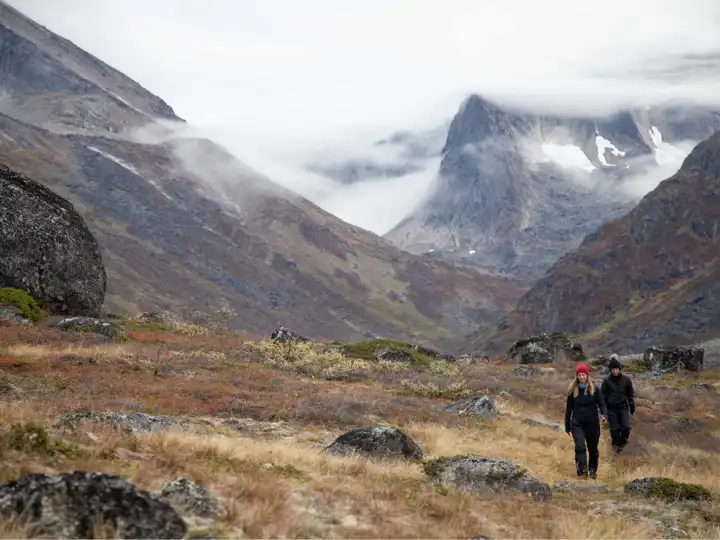
“The vastness of the Arctic is incredible. I was awed by the scenery every day of my journey, as we explored fjords filled with icebergs, climbed over hummocks, and trekked at the base of sky-high mountains. We saw the northern lights several times and caught fog bows and amazing sunsets. It is a photographer’s dream.” -Catherine Brown, Travel Designer
Strict Regulations
Both polar regions are also highly regulated to protect their fragile ecosystems. Many restrictions are in place to minimize human impact on the environment and its threatened flora and fauna. In both the Arctic and Antarctic, visitors have to follow guidelines outlined by the International Association of Antarctica Tour Operators (IAATO).
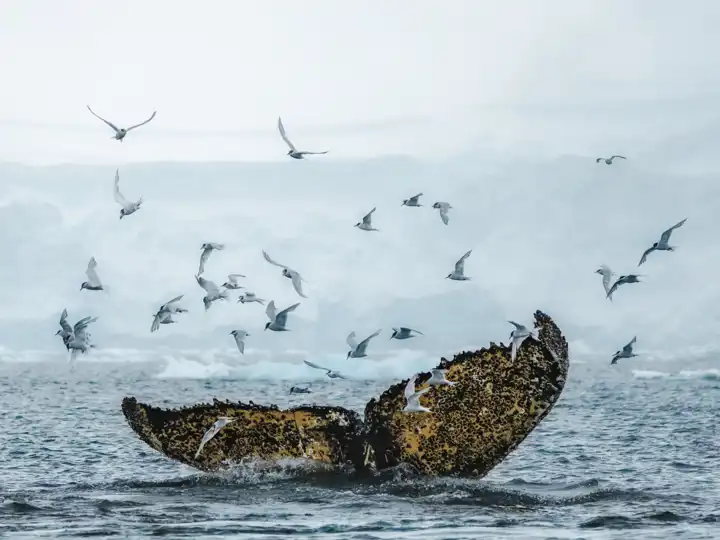
International Claims
Several nations have their hands in governing both the Arctic and Antarctic. Seven countries—Argentina, Australia, Chile, France, New Zealand, Norway, and the United Kingdom—have made territorial claims in Antarctica. However, since 1961, Antarctica has been governed by a Treaty System between 12 different countries who civilly collaborate on scientific and environmental programs.
The Arctic also encompasses several nations. Alaska belongs to the United States, the Canadian Arctic to Canada, Spitsbergen to Norway, and so on. The main difference is that while there are indeed a few ongoing disputes over parts of the Arctic Ocean, the Arctic generally belongs to specific countries.
Expedition Cruise Model
Finally, both Antarctica and the Arctic are conducive to expedition-style trips. Most journeys to Antarctica will involve a polar expedition vessel or a combination of charter flight and vessel to reach the southernmost continent. While South Africa and New Zealand have access to Antarctica, most leisure travelers go through Punta Arenas, Chile or Ushuaia, Argentina, to reach the Antarctic Peninsula more expediently.
The Arctic, too, caters to expedition cruising, with several purpose-built ships exploring the northernmost reaches of Greenland, Iceland, Spitsbergen, the Canadian High Arctic, Alaska, Scandinavia, and the Northwest Passage. This often proves the most efficient and comfortable way to explore more of the Arctic region.

All that said, the Arctic (and even a small portion of Antarctica accessible only from South Africa) can also be explored in-depth by land. This requires both commercial and charter flights and, in some cases, crossovers by land vehicle. For example, Nuuk, Greenland, now has a direct flight from Newark via United Airlines. Meanwhile, other key Arctic hubs like Longyearbyen on Spitsbergen, Kittilä in Finland, and Kiruna in Sweden can be reached via daily scheduled flights from Oslo, Helsinki, and several European hubs. In Canada, charter flights from gateway cities like Ottawa, Toronto, and Edmonton allow travelers to access remote Inuit communities.
Antarctica versus The Arctic: Which Will You Choose?
Now that you understand the main differences and similarities between our planet's fascinating polar regions, which do you choose?
(The right answer is both.)
Feeling ready to take on the polars? Go to our Polar Products and Packing Guide to make sure you've got everything you need or contact a travel designer to start planning.
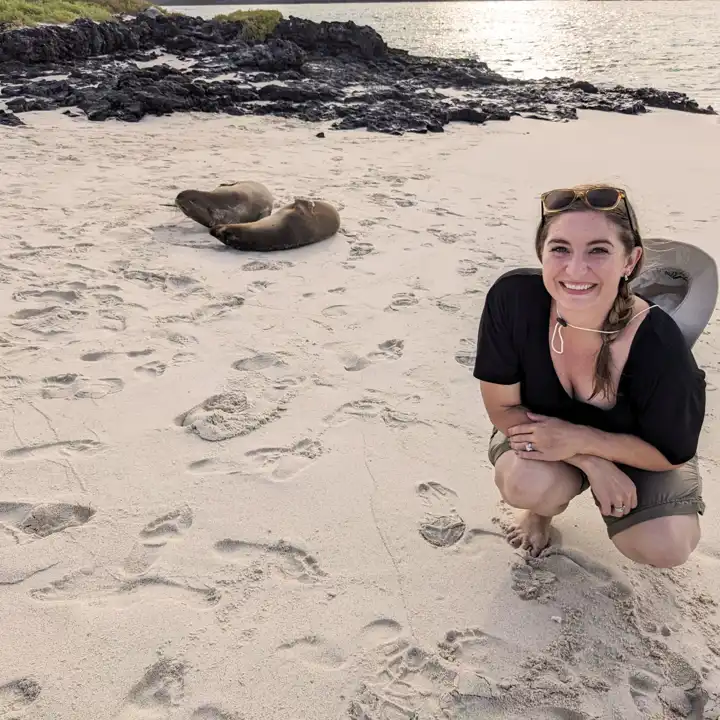
Elizabeth Frels
A veritable RV kid, Elizabeth's love for travel began early on coast-to-coast road trips with her family from her home state of Kansas. Since then, she has lived in London, studied ancient civilization along the Mediterranean, cruised through the Galapagos, hiked through Peru and Patagonia, sipped wine in New Zealand, joined mission trips to Nigeria and Uganda, and shopped the souks in Dubai. When she isn't planning her next adventure, she can be found gardening, baking, biking, and hiking with her husband and children in Colorado.
Inquire Now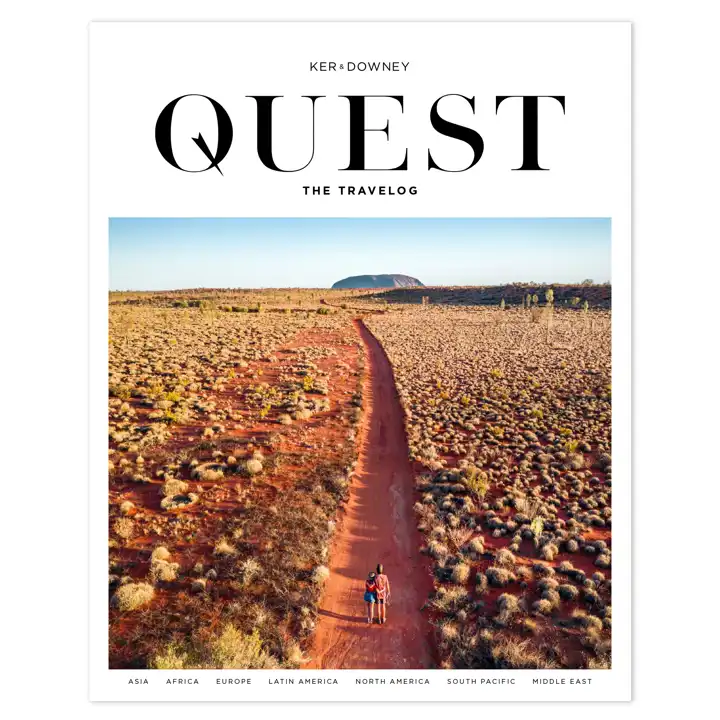
Quest Magazine
Dedicated to the experiential style of Ker & Downey travel, QUEST Magazine features eye-opening content that focuses on unforgettable experience, unheard-of destinations, and the very best our world has to offer. Each issue is packed with insider information, what's new in the world of travel, and editorial pieces that focus on our global culture, philanthropy, and transformative travel.
Read The Spring 2025 IssueSee What We Are Up To
Subscribe to our Weekly Newsletter for Travel Tips and Insider Guides for Planning your Next Journey!
